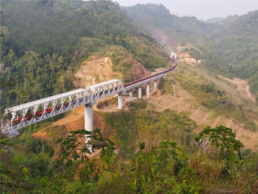In a groundbreaking endeavor to enhance connectivity and foster regional development, Assystem Stup has embarked on a transformative project, in collaboration with the Indian Railways, connecting the Northeastern states of Mizoram, Manipur, and Nagaland with Assam. Spearheaded by the Structural Design team at Assystem Stup, this project will improve connectivity and support sustainable transportation.
Connecting the Unconnected
The Northeastern states of India, known for their stunning landscapes and unique culture, have long faced connectivity challenges due to their rugged terrain. However, Assystem Stup, in collaboration with Indian Railways, is determined to bridge these gaps and bring these states closer to the rest of the country while ensuring the advancement of the energy transition in India.
The ambitious project involves the construction of a railway link connecting the capitals of Mizoram, Manipur, Nagaland, and Assam. This effort has already seen the design and construction of a remarkable number of bridges in these regions, including the world’s tallest bridge pier at a staggering 141 meters above the riverbed.
A Triumph of Engineering and Sustainability
While the project’s scale and engineering feats are impressive, it’s the sustainability angle that sets it apart. Assystem Stup’s primary objective in India is to positively impact energy efficiency and reduce emissions, and this project serves as a testament to that commitment.
One of the key components of this sustainability drive is to support electric trains in future. By transitioning to electric power, these railways can significantly reduce energy consumption and emissions, aligning with India’s broader efforts to combat climate change. The move towards cleaner transportation options reflects a holistic approach to sustainability in infrastructure development.
Tackling Technical Challenges
The challenging terrain of the Patkai region, part of the eastern Himalayan route, has presented various technical challenges. Foundation designs with 1.5-meter diameter piles penetrating rock layers up to 30 meters deep, rigorous seismic analyses, slope stability assessments, and wind tunnel tests are just some of the complex tasks that have been executed with precision.
The project doesn’t just address connectivity; it also emphasizes safety and resilience in the face of environmental factors like earthquakes and high winds. The design integrates various international standards and codes, ensuring the infrastructure’s robustness.
A Sustainable Future for India
Mohammad Asad, General Manager of the East Region at Assystem Stup was quoted saying, “This project is more than just railway development; it’s a journey towards a sustainable future. It promises enhanced connectivity for the people of the Northeast, facilitating economic growth, and boosting tourism. By combining innovation with clean energy and eco-friendly infrastructure, Assystem Stup and Indian Railways are setting a new standard for sustainable development”.
As work on this monumental project continues, it stands as a pillar of human innovation and determination. The railway lines may connect capitals, but they’re also connecting us to a cleaner, brighter future.
Stay tuned for more updates on this incredible endeavor as it unfolds.
Share
